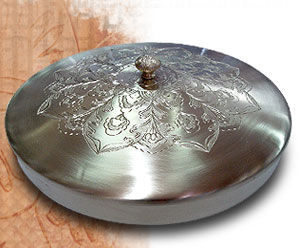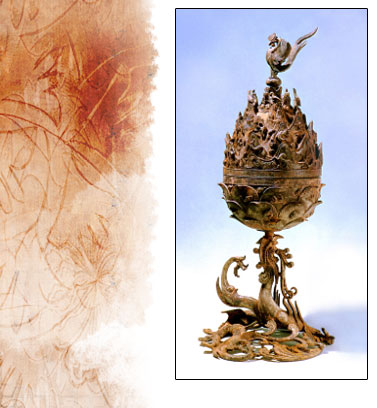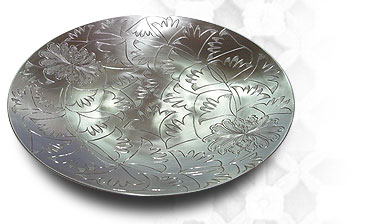Hammering begins on a round metal block, which is cooling down after being poured out of a melting pot. After
 several thousand beats of the hammer, the metal lump finally takes the form of a bowl. As soon as the
several thousand beats of the hammer, the metal lump finally takes the form of a bowl. As soon as the
 alloy of copper and tin passes through the door of secrets by the long process of forging, the
alloy of copper and tin passes through the door of secrets by the long process of forging, the
 vessel begins to exhibit its beauty that manifests the glorious brilliance of gold.
vessel begins to exhibit its beauty that manifests the glorious brilliance of gold.
 Bronzeware has been made in Korea since the Bronze Age. During the period of Unified Bronzeware has been made in Korea since the Bronze Age. During the period of Unified
 Silla (668-935), the Cheoryujeon (Office of Iron and Bronze), a government unit in charge
Silla (668-935), the Cheoryujeon (Office of Iron and Bronze), a government unit in charge
 of bronzeware production, was established; however, it was in the Goryeo Period (918-1392),
of bronzeware production, was established; however, it was in the Goryeo Period (918-1392),
 that the Korean people developed the art of bronzeware making to a very high level, producing
that the Korean people developed the art of bronzeware making to a very high level, producing
 all kinds of kitchenware for use by the ruling class, Buddhist objects and musical instruments. all kinds of kitchenware for use by the ruling class, Buddhist objects and musical instruments.
 Artisans of Silla and Goryeo were able to produce high-quality copper alloys and exported them to
Artisans of Silla and Goryeo were able to produce high-quality copper alloys and exported them to
 neighboring countries under the names Silladong ('Silla Copper') and Goryeodong ('Goryeo Copper').
neighboring countries under the names Silladong ('Silla Copper') and Goryeodong ('Goryeo Copper').
 The remaining relics of the time vividly display their outstanding ability to make exceptional-quality alloys,
The remaining relics of the time vividly display their outstanding ability to make exceptional-quality alloys,
 bronzeware and bronze art works.
bronzeware and bronze art works.

 Gilt-bronze Incense Burner of Baekje Gilt-bronze Incense Burner of Baekje
 Baekje, 6th century Baekje, 6th century
 64cm in height, 19cm in diameter (body) 64cm in height, 19cm in diameter (body)
 Consisting of a base, body and lid, this magnificent Baekje incense Consisting of a base, body and lid, this magnificent Baekje incense
 burner exhibits a perfect form luxuriously decorated with figures symbolizing burner exhibits a perfect form luxuriously decorated with figures symbolizing
 the dream, an ideal and eternal world of Baekje people. The top of the dream, an ideal and eternal world of Baekje people. The top of
 the lid displays the dynamic figure of a phoenix holding a magic pearl in the lid displays the dynamic figure of a phoenix holding a magic pearl in
 her bosom, ready to fly with open wings and a raised tail. The lower part of her bosom, ready to fly with open wings and a raised tail. The lower part of
 the lid captures five musicians residing in the remotest part of the mountains; the lid captures five musicians residing in the remotest part of the mountains;
 creatures with a human face and a body belonging to birds and creatures with a human face and a body belonging to birds and
 beasts; and animals of both the real and imaginary world including tigers beasts; and animals of both the real and imaginary world including tigers
 and deer in a landscape filled with rocks, roads, streams, waterfalls and and deer in a landscape filled with rocks, roads, streams, waterfalls and
 lakes, offering a spectacular panoramic view of the imaginary world lakes, offering a spectacular panoramic view of the imaginary world
 where Taoist hermits were believed to reside. The body carved in the where Taoist hermits were believed to reside. The body carved in the
 shape of an open lotus blossom also exhibits a dramatic spectacle of shape of an open lotus blossom also exhibits a dramatic spectacle of
 human and animal figures. The base, which has a circular form made by human and animal figures. The base, which has a circular form made by
 the legs and tail of a dragon biting the lower part of the main body’s lotus the legs and tail of a dragon biting the lower part of the main body’s lotus
 blossom, gives remarkable stability to the entire work. Captured in the blossom, gives remarkable stability to the entire work. Captured in the
 vitalized motion of soaring into the sky with raised head and leg, and vitalized motion of soaring into the sky with raised head and leg, and
 curled body, the dragon looks as if it is supporting the whole universe. curled body, the dragon looks as if it is supporting the whole universe.
Bangjja yugi, or 'forged bronzeware,' is a term referring to the bronze utensils made by hammering heated copper
alloy into shapes. In fact, the bronze items made in this way are only known to exist in Korea, where the art was used
for making the highest-quality kitchen utensils of the royal households and aristocratic families. A piece of bangjja
yugi ware demonstrates the remarkable feature of changing color if it touches poisonous substances, such as
chemicals, in food; thus, it keeps food fresh for a long period of time and kills harmful bacteria that causes food
poisoning. The amazing capacity of this utensil has even been proved by a recent scientific test.
Korean bronzeware is generally classified into three categories: jumul
('cast'), bangjja ('forged'), and ban-bangjja ('semi-forged') ware,
according to the methods of production. Items belonging to the
first category, jumul yugi, are made by a relatively simple, and
the most commonly performed, process of pouring hot copper
alloy into a cast or mold. Articles of the second category, bangjja
yugi, are made through a hard, time-consuming procedure in
which the artisan needs to hammer a lump of heated metal
innumerable times to turn it into a pre-conceived form. The works
of this type are regarded as the best of all bronzeware. The third type,
ban-bangjja yugi, is made by combining the two methods above.
During the Joseon Period (1392-1910), the government operated bronzeware workshops in both the capital and the
provinces, helping to distribute bronze items used daily in kitchens all across the country along with ceramic ware.
The use of bronzeware, however, became drastically reduced in modern times as stainless steel and plastic wares
appeared. But there has been one man, Yugijang ('Master Yugi Artisan) Yi Bong-ju (born in the North Korean town of
Napcheong, home of bangjja yugi) who has been committed to reviving the beauty of traditional bronzeware on
dining tables today.
View the master's works
|



















